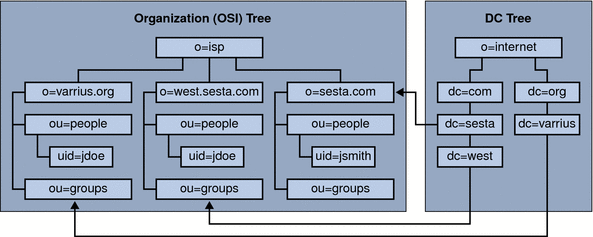Organization of the LDAP Directory
With a hosted domain installation, the LDAP directory is organized into distinct, non-intersecting sections, each of which represents a domain found in the Domain Name System (DNS). User, group and resource uids are unique within each domain. For example, there can be only one user in each domain with the uid of jdoe. A distinguished name (DN) describes the root of each domain.
Calendar Server supports both of these LDAP directory schema versions for hosted domains:
-
Sun LDAP Schema 2 (compatibility or native mode)
When you run the Directory Server Setup script (comm_dssetup.pl), you can choose either LDAP Schema 1 or LDAP Schema 2. Several considerations are:
-
New Installation — If your site is installing Calendar Server 6 2005Q4 as a new installation, use LDAP Schema 2.
-
Upgrade — If your site is upgrading from Calendar Server version 5, use the schema version as follows:
-
If you want to use Access Manager features such as single sign-on (SSO), or if you want to use Delegated Administrator, choose LDAP Schema 2.
-
If you do not have hosted domains, don’t want to use Access Manager features, or don't want to provision users with Delegated Administrator, you can use either schema version. However, use LDAP Schema 2, if possible.
-
Sun LDAP Schema 2
The following graphic shows an LDAP directory organization for a hosted domain installation that uses Sun LDAP Schema 2.
Figure 11–1 LDAP Directory Organization Using LDAP Schema 2

LDAP Schema 2 uses a flat LDAP directory organization, that is, the domains are all at the same level; they are not nested. For a hosted domain installation, the first level entries (as shown by varriusDomain, sestaDomain, and siroeDomain in the graphic) must be parallel in the directory organization. These entries cannot be nested.
If you want to use Access Manager features such as single sign-on (SSO), or use Delegated Administrator to provision users, Schema 2 is required. However, there is a hybrid variation, a two tree scheme that uses both the DC tree and the Organization tree, much like Schema 1, but it uses the Schema 2 object classes and attributes. This is Schema 2 compatibility mode, which is called Schema 1.5 in the configuration program (csconfigurator.sh).
Sun LDAP Schema 1
The graphic that follows shows an example of an LDAP directory organization for a hosted domain installation that uses Sun LDAP Schema 1.
This organization includes two trees for domain management: a DC tree and an Organization tree (OSI)
-
DC tree
-
Organization (OSI) tree
Figure 11–2 LDAP Directory Organization Using LDAP Schema 1

The DC tree (node) is similar to the DNS, which determines a domain entry given the domain name. The inetdomainbasedn LDAP attribute points to the base DN, which is the root of the domain’s users, resources and groups in the organization tree (node). Within each domain, the identifiers for Calendar Server users, resources, and groups must be unique.
Note –
If your earlier LDAP configuration did not contain a DC tree, in order to use Schema 1 mode or Schema 2 compatibility mode, you must create the DC tree nodes yourself as explained in Setting up a Hosted Domain Environment.
In a hosted domain installation using LDAP Schema 1, a directory search requires these two steps to find an entry:
-
In the DC tree, the search operation locates the domain entry that contains the value of the DN pointing to the base DN (inetDomainBaseDN attribute) of domain in the organization tree.
-
In the organization tree, the search operation locates the domain entry and then searches from that entry’s base DN to find the user, resource, or group within the domain.
- © 2010, Oracle Corporation and/or its affiliates
